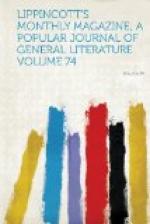The pavement of a part of this thoroughfare is unique. It consists of old tombstones. In 1842, the entire available space in the churchyard being covered with graves, the benchers decided to permit no more interments there, and ordered it to be paved over. A path now runs directly across the old cemetery, where rest the bones of the Knights Templar and their dependants, and many of the sculptured stones have become paving-flags. Worn and polished by the passage of many feet, the epitaphs are entirely defaced. Here and there a few letters of antique cut may with difficulty be deciphered; but soon no sign will survive to tell of this painful desecration.
A little outside the roadway the ground is slightly elevated, and near to, but outside of, the gilt-tipped railings which enclose the Temple Church lies a very unpretending slab of marble. Rising but a few inches above the level, one corner sunken and green with earth-mould, it is but a single remove from the general decay around it. No fence protects it, children play and fight their mimic battles thereon, and when last we saw it a group of workmen employed near by were discussing their noontide bread and cheese and beer in various lounging attitudes upon it. The slab is sadly chipped, yet it is not nearly so old as the years of the century. Surely the man whose death it commemorates departed this life
Unwept, unhonored, and unsung.
Not so. Let us scrape aside the accumulated dirt, and trace with finger-tip the fast-vanishing inscription. It says, “Here lies Oliver Goldsmith.” This, then, is the way the world reveres its great ones. Of what avail a monument to the poet in Westminster Abbey, dignified by the celebrated epitaph of Dr. Johnson, when his tomb is thus relegated to the domain of neglect and oblivion? Even the site at present indicated is “entirely conjectural:” the precise position of the poet’s grave has been long forgotten.
Goldsmith Buildings, of course, take their name from the erratic poet and playwright. In one of them he lived and died, just above the rooms tenanted by the learned Blackstone, who, at that time engaged in penning the fourth volume of his “Commentaries,” was often grievously annoyed by the dancing- and drinking-parties, the games of blind-man’s-buff, and the noisy singing of “poor Noll” and his boon companions. Goldsmith took up residence in the Temple in the spring of the year 1764, in a very shabby set of rooms, which he shared with Jeffs, the butler of the society. Here Dr. Johnson visited him, says Mr. Forster, “and on prying and peering about in them after his short-sighted fashion, flattening his face against every object be looked at, Goldsmith’s uneasy sense of their deficiencies broke out. ‘I shall soon be in better chambers, sir, than these,’ he said. ‘Nay, sir,’ answered Johnson, ’never mind that: nil te quaesiveris extra.’”




